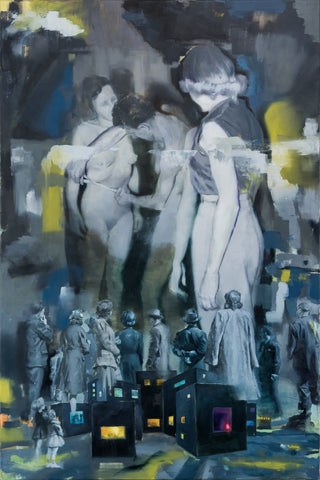Who stands among the most famous Surrealism artists? Without a doubt, some names that immediately spring to mind are Salvador Dali, Rene Magritte, Joan Miro, Max Ernst, and Frida Kahlo. What made surrealism artists famous was their ingenious, dreamlike imagery used to evoke wild associations in viewers. Today, we’ll discuss the lives and art of the well-known Surrealist artists who used their excellent craftsmanship to capture audiences worldwide.
Salvador Dali
No debate on Surrealism can begin without mentioning its most well-known artist. Salvador Dali was a Spanish Surrealist whose eccentric reputation certainly precedes him. Dali’s groundbreaking works, in particular, paintings of the famous melting clocks, earned him international renown. He pioneered a particularly bewildering painting technique known as the “paranoiac-critical method,” which involved deliberately entering into a paranoid state to create fantastical and bizarre imagery through a deconstruction of the self. Dali’s contributions to Surrealism and his unique artistic vision solidified him as one of the most influential artists not just in the twentieth century but across all periods of art.
René Magritte
In his work, René Magritte explored the relationship between reality and illusion. In a manner typical for Surrealists, he blended the line separating the two to challenge and twist the viewer’s perception. Some of his most famous paintings placed everyday objects and juxtaposed them to mystify, confuse, or outright shatter notions of reality that we take for granted. Magritte’s almost philosophical approach to art made him stand out among his peers.
Joan Miró
Joan Miró was a Spanish painter, sculptor, and ceramicist known for his explorations of the difficulties of modern life. Interestingly enough, as his artistic expression matured, he delved deeper into creations that were much more playful and childlike. Miró gained international recognition through vivid colors and infantile recreations of animals and landscapes. Though his artwork may seem shallow at first glance, the symbolism buried within invites reflection on existential subjects, like the subconscious, the cosmos, and the human experience.
Max Ernst
As an artist, Max Ernst garnered attention for techniques used to create his art: frottage and grattage, which he used to add texture and layers to his paintings. Ernst’s work often depicts mythological themes, as well as dreams and the subconscious mind. In a fashion typical for Surrealism, he blends realism together with the fantastical. Thanks to his contributions, he is considered one of the pioneers of Surrealism and Dadaism. Additionally, many credit him with heavy influence on other, derivative movements, particularly Abstract Expressionism.

Electric Dream 60" x 40" oil on canvas - Joshua Flint
Frida Kahlo
Frida Kahlo’s hallmark was the emotionally raw (and often autobiographical) depictions that drew heavily from Mexican culture and folklore. Her paintings often portray her physical and emotional pain, much of which is connected with her early life, where she struggled with health issues and accidents. Despite her posthumous success, her art never earned widespread acclaim during her life – in fact, she was able to host only a single exhibition of her art.
Jean Arp
Jean Arp was a sculptor, painter, and poet associated with the Dada and Surrealist movements. Much like Miró, plenty of his oeuvre focuses on biomorphic subjects such as plants, animals, and the human body. His works demonstrated the connections between humanity and nature. Interestingly, though he was initially involved with the Surrealist movement, later on in his life and career, he became associated with Constructivism, a school that favored a more rational and realistic approach to art. Still, this versatility makes his artistry an all the more impressive feat.
Man Ray
The enigmatic persona of Man Ray (born Emmanuel Radnitzky) earned him respect and recognition on the international art scene thanks to the variety of media he produced. Though he considered himself a painter most of all, Man Ray adopted and pioneered photography as a salient medium for his art. He developed new and innovative techniques, including solarization and his self-titled “rayography.” As a multi-faceted and cross-disciplinary artist and innovator, Man Ray’s contributions to Surrealism cannot be understated.
Leonora Carrington
A highly individualistic artist, Carrington played a key role in Surrealism as one of its most influential female representatives. She was closely associated with Max Ernst, whose work she had admired so much that she became enamored with the man before even meeting him. Carrington always stressed that her paintings were her own, having never imagined that anyone else would take interest. In her art, she leaned strongly on themes of magic realism, symbolism, and sexuality.
The Takeaway
Surrealism relied on mystical, dreamlike imagery to challenge concepts of reality. Truly, nothing was set in stone or untouchable for the Surrealists, and their work often puzzled viewers attempting to decipher its meaning. We hope you’re now more familiar with Surrealism as a whole – the art produced in the movement remains certainly worth exploring today.
